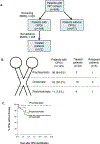The Use of Magnetic Resonance Imaging Screening for Optic Pathway Gliomas in Children with Neurofibromatosis Type 1
- PMID: 26233602
- PMCID: PMC9100836
- DOI: 10.1016/j.jpeds.2015.07.001
The Use of Magnetic Resonance Imaging Screening for Optic Pathway Gliomas in Children with Neurofibromatosis Type 1
Abstract
Objective: To evaluate the utility of screening brain/orbital magnetic resonance imaging (MRI) in a large population of children with neurofibromatosis type 1 (NF1) over a 20-year period.
Study design: A retrospective analysis of clinical and imaging data from children with NF1 seen at a single center between 1990 and 2010 was performed.
Results: During the 20-year study period, 826 individuals with NF1 (402 females, 424 males) ages 1-9 years were screened for optic pathway gliomas (OPGs) using brain/orbital MRI; 18% were identified with OPGs with a median age at detection of 3 years. Fifteen percent of patients with OPGs had radiologic or clinical progression requiring therapy. Children with chiasmatic and postchiasmatic tumors were more likely to require therapy compared with patients with prechiasmatic OPGs (P < .0001). Patients with visual deficits at the time of diagnosis were more likely to experience visual decline despite therapy when compared with patients treated based on radiologic progression (P < .012).
Conclusions: Our findings confirm that chiasmatic and postchiasmatic OPG in children with NF1 have the highest risk for progression and vision loss. Early identification of OPG by screening MRI prior to the development of vision loss may lead to improved visual outcomes. Children with negative brain and orbital MRI screening at age 15 months or later did not develop symptomatic OPGs.
Copyright © 2015 Elsevier Inc. All rights reserved.
Conflict of interest statement
The authors declare no conflicts of interest.
Figures
Similar articles
-
Optic pathway gliomas in patients with neurofibromatosis type 1: follow-up of 44 patients.J AAPOS. 2010 Apr;14(2):155-8. doi: 10.1016/j.jaapos.2009.11.020. J AAPOS. 2010. PMID: 20451859
-
Optic Pathway Gliomas in Neurofibromatosis Type 1: An Update: Surveillance, Treatment Indications, and Biomarkers of Vision.J Neuroophthalmol. 2017 Sep;37 Suppl 1(Suppl 1):S23-S32. doi: 10.1097/WNO.0000000000000550. J Neuroophthalmol. 2017. PMID: 28806346 Free PMC article. Review.
-
Feasibility and comparison of visual acuity testing methods in children with neurofibromatosis type 1 and/or optic pathway gliomas.Invest Ophthalmol Vis Sci. 2013 Feb 5;54(2):1034-8. doi: 10.1167/iovs.12-11385. Invest Ophthalmol Vis Sci. 2013. PMID: 23329671
-
Fractional anisotropy of the optic radiations is associated with visual acuity loss in optic pathway gliomas of neurofibromatosis type 1.Neuro Oncol. 2013 Aug;15(8):1088-95. doi: 10.1093/neuonc/not068. Epub 2013 May 7. Neuro Oncol. 2013. PMID: 23658320 Free PMC article.
-
Optic Pathway Glioma and Cerebral Focal Abnormal Signal Intensity in Patients with Neurofibromatosis Type 1: Characteristics, Treatment Choices and Follow-up in 134 Affected Individuals and a Brief Review of the Literature.Anticancer Res. 2016 Aug;36(8):4095-121. Anticancer Res. 2016. PMID: 27466519 Review.
Cited by
-
Surveillance magnetic resonance imaging for isolated optic pathway gliomas: is gadolinium necessary?Pediatr Radiol. 2018 Sep;48(10):1472-1484. doi: 10.1007/s00247-018-4154-4. Epub 2018 May 22. Pediatr Radiol. 2018. PMID: 29789890
-
Non-pharmacological strategies to obtain usable magnetic resonance images in non-sedated infants: Systematic review and meta-analysis.Int J Nurs Stud. 2020 Jun;106:103551. doi: 10.1016/j.ijnurstu.2020.103551. Epub 2020 Feb 22. Int J Nurs Stud. 2020. PMID: 32294563 Free PMC article.
-
Evaluating Focal Areas of Signal Intensity (FASI) in Children with Neurofibromatosis Type-1 (NF1) Treated with Selumetinib on Pediatric Brain Tumor Consortium (PBTC)-029B.Cancers (Basel). 2023 Mar 31;15(7):2109. doi: 10.3390/cancers15072109. Cancers (Basel). 2023. PMID: 37046770 Free PMC article.
-
Effect of age and neurofibromatosis type 1 status on white matter integrity in the optic radiations.Neurooncol Adv. 2020 Jun 25;2(Suppl 1):i150-i158. doi: 10.1093/noajnl/vdaa037. eCollection 2020 Jul. Neurooncol Adv. 2020. PMID: 32642741 Free PMC article.
-
Impact of systemic anticancer therapy in pediatric optic pathway glioma on visual function: A systematic review.PLoS One. 2021 Oct 21;16(10):e0258548. doi: 10.1371/journal.pone.0258548. eCollection 2021. PLoS One. 2021. PMID: 34673789 Free PMC article.
References
-
- Sharif S, Upadhyaya M, Ferner R, Majounie E, Shenton A, Baser M, et al. A molecular analysis of individuals with neurofibromatosis type 1 (NF1) and optic pathway gliomas (OPGs), and an assessment of genotype-phenotype correlations. J Med Genet 2011;48:256–60. - PubMed
-
- Moharir M, London K, Howman-Giles R, North K. Utility of positron emission tomography for tumour surveillance in children with neurofibromatosis type 1. Eur J Nucl Med Mol Imaging 2010;37:1309–17. - PubMed
-
- Binning MJ, Liu JK, Kestle JR, Brockmeyer DL, Walker ML. Optic pathway gliomas: a review. Neurosurg Focus 2007;23:E2. - PubMed
-
- Jahraus CD, Tarbell NJ. Optic pathway gliomas. Pediatr Blood Cancer 2006;46:586–96. - PubMed
-
- Nicolin G, Parkin P, Mabbott D, Hargrave D, Bartels U, Tabori U, et al. Natural history and outcome of optic pathway gliomas in children. Pediatr Blood Cancer 2009;53:1231–7. - PubMed
MeSH terms
Grants and funding
LinkOut - more resources
Full Text Sources
Medical
Research Materials
Miscellaneous


